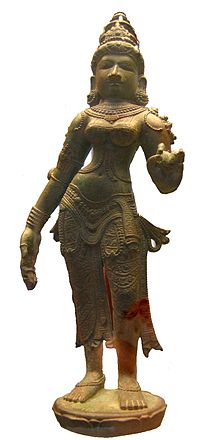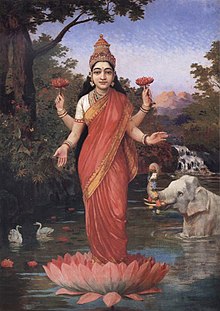Devi
[2] Goddesses such as Durga, Kali, Lakshmi, Parvati, Radha, Saraswati and Sita have continued to be revered in the modern era.
The Vedas name numerous cosmic goddesses such as Prithvi (earth), Aditi (cosmic moral order), Vāc (sound), Nirṛti (destruction), Ratri (night) and Aranyani (forest); bounty goddesses such as Dinsana, Raka, Puramdhi, Parendi, Bharati and Mahi are among others are mentioned in the Rigveda.
[2]: 18–19 All gods and goddesses are distinguished in Vedic times,[2]: 18 but in post-Vedic texts, particularly in the early medieval era literature, they are ultimately seen as aspects or manifestations of one Devi, the Supreme Power.
Examples of this are Parvati with Shiva in Shaivism, Saraswati with Brahma in Brahmanism and Lakshmi with Vishnu, Sita with Rama and Radha with Krishna in Vaishnavism.
[20][21][22] Devi-inspired philosophy is propounded in many Hindu texts such as the Devi Upanishad, which teaches that Shakti is essentially Brahman (ultimate metaphysical Reality) and that from her arises prakṛti (matter) and purusha (consciousness) and that she is bliss and non-bliss, the Vedas and what is different from it, the born and the unborn and all of the universe.
She is, states Devi, the eternal and infinite consciousness engulfing earth and heaven, and 'all forms of bliss and non-bliss, knowledge and ignorance, Brahman and Non-Brahman'.
The tantric aspect in Devi Upanishad, says June McDaniel, is the usage of the terms yantra, bindu, bija, mantra, shakti and chakra.
[13] Among the major world religions, the concept of Goddess in Hinduism as the divine feminine has had the strongest presence since ancient times.
Rita Gross states,[32] the view of Parvati only as an ideal wife and mother is an incomplete symbolism of the power of the feminine in the mythology of India.
Parvati's numerous aspects, states Gross, reflect the Hindu belief that the feminine has a universal range of activities, and her gender is not a limiting condition.
[2][32] In Hindu belief, Parvati is the recreative energy and power of Shiva, and she is the cause of a bond that connects all beings and a means of their spiritual release.
[35] In Indian art, this vision of ideal couple is derived from Shiva and Parvati as being half of the other, represented as Ardhanarishvara.
[42] The marriage and relationship between Lakshmi and Vishnu as wife and husband, states Patricia Monaghan, is "the paradigm for rituals and ceremonies for the bride and groom in Hindu weddings.
"[44] Archaeological discoveries and ancient coins suggest the recognition and reverence for goddess Lakshmi in the Scytho-Parthian kingdom and throughout India by the 1st millennium BCE.
[46] Lakshmi's iconography and statues have also been found in Hindu temples throughout Southeast Asia, estimated to be from second half of 1st millennium CE.
Her iconography is typically in white themes from dress to flowers to swan – the color symbolizing Sattwa Guna or purity, discrimination for true knowledge, insight and wisdom.
The four hands hold items with symbolic meaning – a pustaka (book or script), a mala (rosary, garland), a water pot, and a musical instrument (lute or vina).
[50] The book she holds symbolizes the Vedas representing the universal, divine, eternal, and true knowledge as well as all forms of learning.
[50] The musical instrument, typically a veena, represents all creative arts and sciences,[56] and her holding it symbolizes expressing knowledge that creates harmony.
Her legends appear in the medieval era, as an angry, ferocious form of the mother goddess Mahalakshmi, who assumes the avatar of Durga .
[62] In the Shaktism traditions of Hinduism, found particularly in eastern states of India, Durga is a popular goddess form of Adishakti.
In the medieval era composed texts such as the Puranas, she emerges as a prominent goddess in the context of crisis, when evil asuras were on the ascent.
She is described in the text, state Shimkhanda and Herman, as the "one great body of cosmos", and same as Devis "Durga, Jaya and Siddha, Lakshmi, Gayatri, Saraswati, Parvati, Savitri".
[71] In Valmiki Ramayana, Sita is repeatedly expressed as the manifestation of Lakshmi, as the one who blesses abundance in agriculture, food, and wealth.
She has figured prominently in the poems of Vidyapati (1352–1448) as a cosmic queen and later became inspiration behind many forms of art, literature, music and dance.
[77] Theological texts projected Mahadevi as ultimate reality in the universe as a "powerful, creative, active, transcendent female being.
She focuses on that side of her that suits her objectives, but unlike male Hindu deities, her powers and knowledge work in concert in a multifunctional manner.
The adepts believe, state John Stratton Hawley and Donna Marie Wulff, that "to establish such yantra is to place the macrocosm within oneself", and doing so can yield temporal benefits, spiritual powers or enlightenment.
[89] Scholars state that the concept of Matrikas as powerful goddesses emerged in the early 1st millennium AD, and possibly much earlier.
They are- Shailputri(daughter of mountain), Brahmacharini(one who does penance), Chandraghanta(the one with a bell shaped moon on her head), Kushmanda(one who formed the 'Anda- universe' with the warmth of her smile), Skandamata(the mother of Skanda-Kartikeya), Katyayani(the daughter of sage Katya), Kalaratri(one who engulfs space and time), Mahagauri(the bright complexioned)and Siddhidatri(one who grants the eight Siddhis-Anima, Mahima, Garima, Laghima, Prapti, Prakamya, Isitva, Vashitva).






